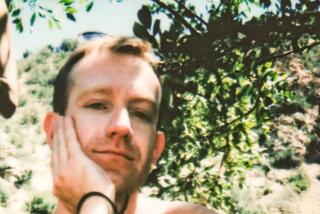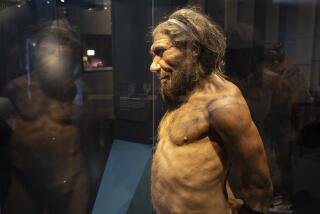The Chalice & the Blade: OUR HISTORY, OUR FUTURE by Riane Eisler (Harper & Row: $16.95; 261 pp.)
- Share via
In his book “1984,” George Orwell foresaw a future in which a “Ministry of Truth” would rewrite society’s books and refashion its ideas so that they would fit the requirements of the men in power. According to Riane Eisler, this eerie phenomenon already happened long ago.
Eisler traces the unseen forces that shape human culture, from prehistory through recorded history and into the future. Her book reconstructs an early world of partnership between men and women, which lasted about 20,000 years, and then veered off on “a bloody 5,000-year detour” of male domination.
She describes herself as blowing the lid off “the biggest cover-up in the world.” At a certain historical turning point, she says, the men in power deliberately buried the truth about the egalitarian nature of past society.
Following 12 years of rigorous research and synthesizing the work of many others, Eisler proposes that conventional historians are painting the wrong picture of the origins of civilization. In the traditional view, Man the Hunter plays the leading role, forming the beginnings of ancient civilization by wielding the lethal blade.
In Eisler’s alternative history, Woman the Gatherer is the central actor. Rather than forming an invisible backdrop, women probably invented the domestication of plants and animals, and new social relations probably stemmed from their relations with children. Ancient peoples worshiped a bountiful female deity, Eisler says, and the life-giving powers of the universe, symbolized by the chalice in the book’s title.
“The best kept secret” is that the first great technological breakthroughs came before the advent of patriarchal society. Innovations such as agriculture, weaving, writing, town planning, commerce, and government were made in cultures that had one feature in common: the worship of the Goddess, the association of woman with the powers that govern life and death.
This reframing of earliest civilization--from male-centered to female-centered--is not Eisler’s unique contribution. Many feminist scholars have, for the last two decades, been re-examining history with fresh eyes.
Some have even gone so far as to conclude that this woman-centered society must have been matriarchal in structure. They reasoned: If men did not dominate women, women must have dominated men.
Eisler, the author of two earlier books on women, offers what might be called a post-feminist viewpoint. The most recent evidence, drawn from new methods and emphasis in archeology, supports neither male nor female domination, she says. Instead, it indicates that pre-patriarchal society was “remarkably egalitarian.” In other words, she may be pointing to a previously unseen social form--partnership society.
To explain further, she proposes that two basic models of society underlie diverse human cultures. The dominator model includes patriarchy and matriarchy. It assumes the ranking of one-half of humanity over the other. The partnership model, in which social relations are based on linking, does not demand inferiority or superiority.
Eisler uses the language of nonlinear dynamics, or the study of chaotic systems, to describe alternating historical cycles of dominance and partnership. Unfortunately, the introduction of these difficult concepts lends the book an academic tone in these sections.
When patriarchy was established around 2500 BC, she says, following the invasions of barbarians into the European and Middle Eastern regions around the Mediterranean, a crucial “bifurcation” took place: Peace and prosperity gave way to war, slavery, and religions based on fear. Later, around the time of Jesus and again in the Renaissance, partnership societies were once more on the rise.
Each cycle has a characteristic type of technological and social evolution, she points out. Therefore the direction of cultural evolution--whether it will be peaceful or warlike--depends on which model guides society.
Eisler’s legal training and constitutional law expertise are evident in the way she makes her case. The text is studded with references to archeologists and historians who are following the same trails. These citations add richness and validity to the book, but also interfere with the simplicity of the story line.
Her historical review is more than an academic exercise. She goes back in time in order to rewrite the future. She asks the Big Questions: Why do we wage war, not peace? What is the source of the “war” between the sexes? What are we to make of ancient legends of the Garden of Eden, or a coming Golden Age?
This ambitious new synthesis so contradicts what we have been taught that its hold on the mind is like a message written in sand. It lingers for a moment but, relentlessly, the force of centuries works to undermine it. Later, after some time has passed, it draws the reader back, curious, hopeful.
Eisler contends that the choices we make as a society today are determined by a history that has been cut and edited by a select few, beginning at a crucial time, a crossroads in the past when the shift from a partnership to a dominator society took hold. Today, she says, we face a similar disjuncture, an evolutionary crossroads from a dominator to a partnership society. She points to signs of change in grassroots movements that seek to create egalitarian relationships, harmony with the environment, and peaceful societies.
However, she warns, we do not know that we wear cultural blinders. Our choices, within the framework of what we have learned to choose, cannot solve our problems. And the path toward partnership is not inevitable.
More to Read
Sign up for our Book Club newsletter
Get the latest news, events and more from the Los Angeles Times Book Club, and help us get L.A. reading and talking.
You may occasionally receive promotional content from the Los Angeles Times.







